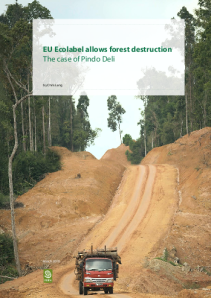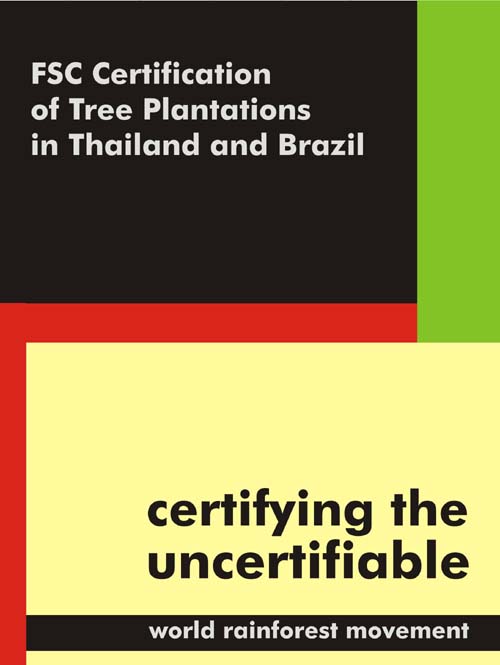Climate scientists and climate negotiators might as well live on different planets.
By Chris Lang. Published in WRM Bulletin 143, June 2009.
The distance between climate science and climate negotiations was dramatically illustrated at the UN climate meeting in Bonn earlier this month. While scientists tell us we need large reductions in greenhouse gas emissions, governments are setting targets for emission reductions that are so low that runaway climate change is almost guaranteed.
At a side event organised by the Potsdam Institute for Climate Impact Research scientists gave a series of presentations under the title: “Emissions in line with staying below 2°C – do current proposals make it?”.[1] Katje Frieler of the Potsdam Institute noted that more than 100 countries call for a target of limiting global warming to 2°C or lower. “How much emission reductions are necessary in order to reach this target?” she asked. The graphs she showed were scary. Business as usual emissions would result in a temperature increase of somewhere between 3°C and 8°C by 2100. But the important figure was 1 trillion tons of CO2. That is the total amount of emissions we can produce between 2000 and 2050 if the probability of exceeding 2°C is to be limited to 25 per cent. The bad news is that we have already emitted one-third of that in the last nine years.
Joeri Rogelj made things worse. He looked at the targets that countries are currently setting for emissions reductions. He concluded that if countries meet the targets that they have currently set, we are “Virtually certain to exceed 2°C”, with median concentrations of CO2 of over 700 parts per million by 2100.
Bill Hare of the Potsdam Institute and Climate Analytics summed up the implications of the findings, which were published in Nature magazine on 30 April 2009.[2] “Less than a quarter of the available and economically recoverable, fossil fuel reserves can still be burned and emitted from 2009 to 2050,” he said.
As George Monbiot has pointed out, “The test of all governments’ commitment to stopping climate breakdown is this: whether they are prepared to impose a limit on the use of the reserves [of fossil fuels] already discovered, and a permanent moratorium on prospecting for new reserves. Otherwise it’s all hot air.”[3]
The urgency in the Potsdam Institute’s presentations was not reflected in the official negotiations in Bonn. None of the government delegations present in Bonn were talking about imposing any limit on using fossil fuels. The Ad Hoc Working Group on Long-Term Cooperative Action under the Convention (AWGLCA) ended up with a 200-page draft negotiating text, which is almost four times as long as the draft produced before the meeting.[4] The Ad Hoc Working Group on the Kyoto Protocol failed to reach any agreement on emission reduction targets beyond 2012. Hot air, in other words.
In addition to stopping the burning and extraction of fossil fuels, we also need to stop deforestation. But little progress was made during the discussions about reducing emissions from deforestation and forest degradation (REDD) in Bonn. In one informal plenary session Michael Zammit Cutajar, the chair the AWGLCA, spoke at length about curly brackets and square brackets. He talked about the “lack of perfection in the curly brackets” and something he called “mind brackets”.
At an AWGLCA meeting on REDD during the second week of the talks, the overwhelming impression was that someone had dreamed up REDD the previous evening over a glass or two of Kölsch. For 90 minutes delegates chatted about REDD as if no previous discussions on REDD had ever happened. Other AWGLCA discussions were fiendishly complex, featuring discussions of REDD plus; REDD and NAMAs; REDD and LULUCF; REDD and MRV; REDD and CBD; REDD and UNDRIPs; REDD and carbon trading; REDD and offsets; and REDD and carbon accounting. What all this means is not the point, since there was little or no agreement on any of this.[5]
But while the official negotiations on REDD are drowning in a soup of acronyms, organisations such as The Nature Conservancy (TNC) are steaming ahead with their own versions of REDD. At a side event in Bonn, TNC’s Sarene Marshall described the Berau REDD Pilot Programme which covers an area of 2.2 million hectares in East Kalimantan. Of this area, 780,000 hectares would be logged. This would be “reduced impact logging / certification”, Marshall’s presentation assured us. The project would then “sell emissions reductions ‘credits’ to voluntary carbon market buyers.”[6]
There are two serious problems here. First, the logging will produce large amounts of emissions. Comparing these emissions with what might have happened under more destructive logging is fraudulent. A new Global Witness report, “Vested Interests – industrial logging and carbon in tropical forests,” documents how reduced impact logging “kills 5-10 non-target trees for every target tree cut, and releases between 10 and 80 tonnes of carbon per hectare.” Logging also makes forests more vulnerable to further deforestation and to fire. “During the El Niño events in the late 1990s, 60% of logged forests in Indonesian Borneo went up in smoke compared with 6% of primary forest,” Global Witness notes.[7]
The second problem is that we need both to reduce emissions from burning fossil fuel and to stop deforestation, especially industrial scale logging of old-growth forests. We cannot offset one against the other. “In practice offsetting is having a disastrous impact on the prospects for averting catastrophic climate change,” writes Friends of the Earth in a new report on offsets. “Offsetting must not be expanded at Copenhagen. New proposed offsetting schemes must be dropped from the negotiations, and existing offsetting mechanisms need to be scrapped.”[8]
The most extraordinary slide in Sarene Marshall’s presentation in Bonn about the Berau project was titled “Berau REDD Phase I Structure”. The slide outlines money transfers. An arrow with three dollar signs goes from “Funders” to “Timber Concessions”. A trust fund and a project management unit are to be established. Under the words “REDD Activities” are three boxes, labelled: “Timber Concessions”, “Oil Palm” and “Protection Forests”. Underneath is the word “offsets”. One box includes the words “Local Government, National Government, Civil society, etc.” and two others are for “Government” and “Communities”. None of these seem to have any role in overseeing the money flows, or anything much else. Marshall’s slide shows the political and financial infrastructure to be established by TNC, a US-based NGO, which has not, at least as far as I’m aware, been elected to govern this area of Kalimantan. This is not democracy. This is carbocracy.[9]
References
[1] The presentations from the side event are available here.
[2] Malte Meinshausen, Nicolai Meinshausen, William Hare, Sarah C. B. Raper, Katja Frieler, Reto Knutti, David J. Frame & Myles R. Allen (2009) “Greenhouse-gas emission targets for limiting global warming to 2 °C“, Nature 458, 1158-1162, 30 April 2009. doi:10.1038/nature08017
[3] George Monbiot (2009) “How Much Should We Leave in the Ground?“, The Guardian, 6 May 2009.
[4] For fans of brackets, here it is: FCCC/AWGLCA/2009/INF.1
[5] For an overview of the REDD discussions (complete with explanations), see Kate Dooley and Nikki Reisch (2009) “Bonn II: REDD discussions at the June 2009 UNFCCC climate meeting“, Forest Watch, FERN, July 2009.
[6] Serene Marshall (2009) “Berau REDD Pilot Program“, presentation at side event in Bonn, 2 June 2009.
A video of TNC’s side event, titled “A global mechanism for REDD+”, is available here.
[7] “Vested interests – Industrial logging and carbon in tropical forests“, Global Witness, June 2009.
[8] “Offsetting: A dangerous distraction“, Friends of the Earth, June 2009.
[9] The word “carbocracy” is borrowed from Larry Lohmann.
Larry Lohmann (2001) “Democracy or Carbocracy? Intellectual corruption and the future of the climate debate“, Corner House Briefing 24, October 2001.
Be warned, this is depressing reading, particular as it was written eight years ago. But it is still essential reading for anyone who wants to understand what’s gone wrong with the UN climate negotiations. Here’s a sample:
Contrary to popular impression, most climate negotiators no longer bother discussing how to make deep cuts in fossil fuel emissions. Nor do they talk seriously about how to share the world’s limited carbon-cycling capacity. Nor do they scrutinize the underlying causes of global warming. Nor do they support the most important existing efforts to adapt to it.
Instead, they squabble over calculations they should know are unscientific — such as how much fossil fuel emissions they might claim that trees are “neutralizing” through photosynthesis. They argue over who is to receive the spoils of “climate mitigation” activities whose fraudulence is well-established — such as subsidies for tree plantations or coal-fired power plants. They lay plans for a carbon market which has no viable accounting system and which would redistribute air and land from poor to rich. Such cynical games have usurped years of negotiations. The same effort could have been more prudently devoted to practical means of addressing global warming and its effects.










Leave a comment